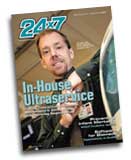
Kelly Stephens, editor of 24x7 magazine, was kind enough to invite me to climb on the Soapbox and well, express myself.
Normally only my mother would be interested in something like this, but since the topic was point-of-care communications and alarm notification, I thought I'd share it with all of you. In my rant I lay out market requirements, the limitations of current solutions and describe my feverish fantasy for improved alarm notification.
Alarm notification (when it really counts) is all about life-threatening alarms (LTAs). The notification and management of LTAs is covered by the “indications for use†in a medical device’s 510k filing with the FDA. The methods or capabilities described in the 510k filing represent the primary means of alarm notification. Any method of alarm notification that is not covered by a device’s 510k filing is a secondary means of alarm notification. Nursing units must be organized, staffed, and managed based on the device’s primary alarm notification. Secondary alarm notification doesn’t count, and any hospital that runs its units based on secondary-alarm-notification capabilities is at risk.
Hospitals need real automation at the point-of-care (including alarm notification) upon which they can safely operate their nursing units and deliver quality care. This means one product that will support a wide range of phones, nurse call systems and medical devices (including integration with ADT, CPOE/OE/RR) - even within the same hospital. And it will require a solution with a 510k.
The vendor that provides this solution with a 510k is going to have a huge competitive advantage because they will have the only product on the market that offers all the benefits of point-of-care automation - the reduced operating costs along with improved patient safety. I wonder who it will be.


Recent Comments